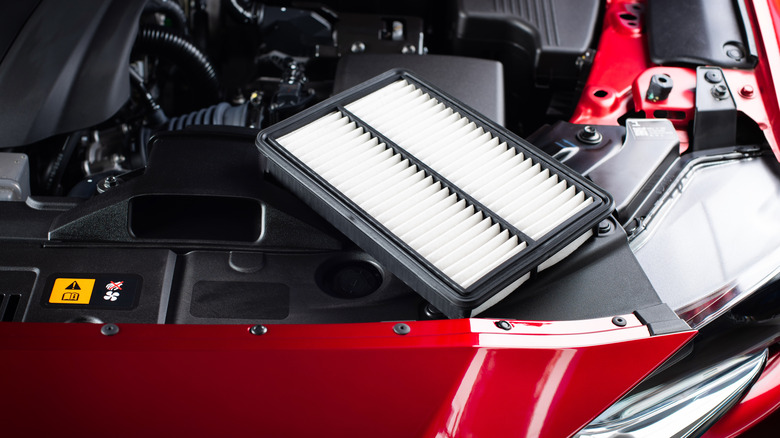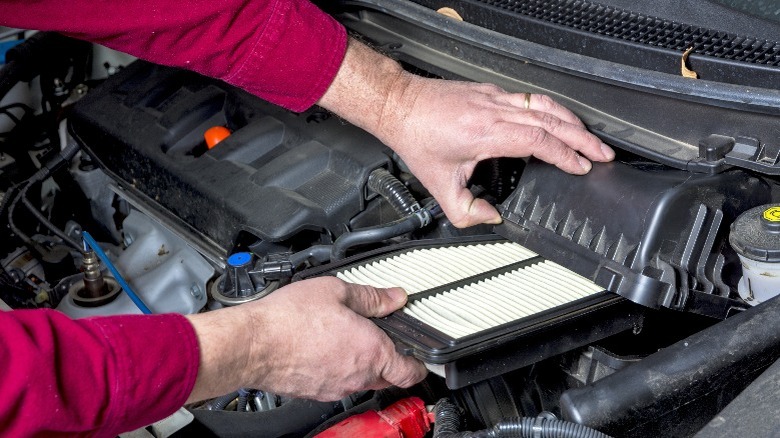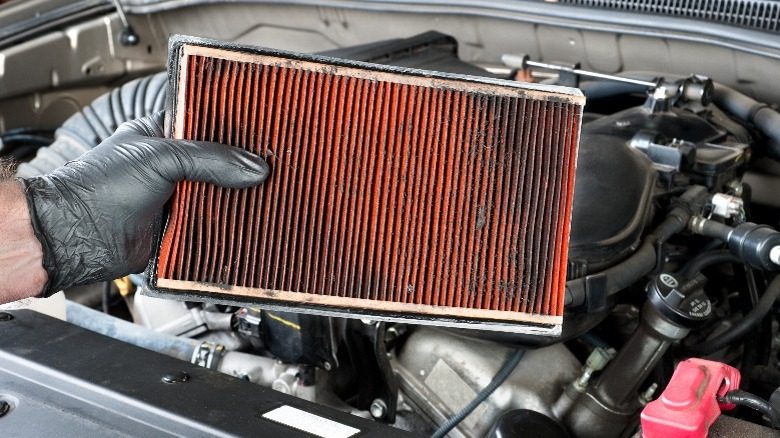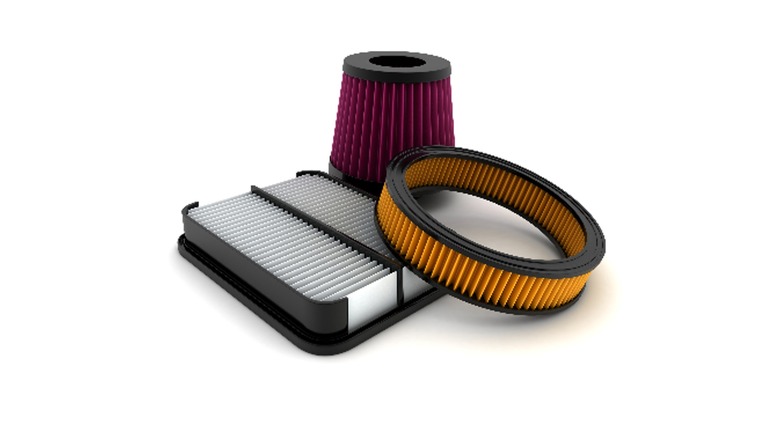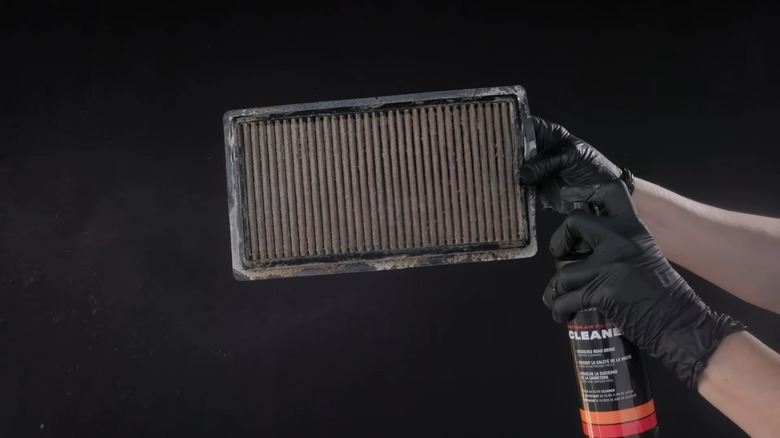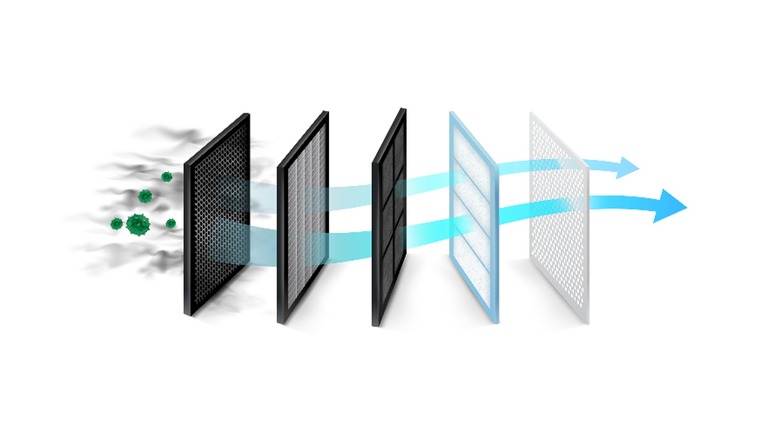How To Change The Engine Air Filter On Your Vehicle (And What To Know Before You Start)
If you drive a car with an internal combustion engine — basically any modern vehicle that isn't electric — it requires a combination of oxygen and fuel to run. The fuel comes in the form of gasoline or diesel; the oxygen comes from the air we breathe all day. As you drive, your car's engine sucks up oxygen from the atmosphere, and it enters the engine through the air intake system. That oxygen then gets mixed with fuel in the engine's combustion chambers and is ignited by the spark plugs — or compressed until ignition in a diesel — resulting in the small, contained explosions that power your vehicle.
While that may seem simple enough, the process is significantly more complex and relies on various individual components to make the system work. One of the parts that aids in your engine's combustion process is the engine air filter, which ensures that the air your engine breathes is clean and free from debris, like leaves, dust, and bugs. Engine air filters are pretty hardy, but they degrade over time and must be replaced regularly. How do you replace your engine air filter, and how do you know when it's time to do so? The answer depends, in part, on your vehicle and your driving habits. But don't worry — the process is simple and quick, and it's an easy DIY auto project that even beginners can tackle. So, let's dive in and check it out. Here's how to change the engine air filter on your vehicle and what you need to know before you start.
How to replace your engine air filter
As with most auto maintenance or repair jobs, you need to gather the proper tools and supplies before you start your engine air filter replacement. While changing your engine air filter is typically an incredibly easy and straightforward job, you may still need a couple of essential tools for DIY maintenance. Depending on your vehicle, you might need a ratchet and socket set, some screwdrivers, or no tools at all. Outside of tools, the only thing you'll need is a replacement air filter.
Once you have your new air filter and the proper tools, you can get started on the following steps:
-
Open your car's hood.
-
Locate the air filter housing, also known as the air box.
-
Open the air box by removing any fasteners or clips that secure the box lid in place.
-
Remove the old air filter, paying close attention to its orientation.
-
Clean any dust or debris inside the air box.
-
Install the new air filter according to the directional arrows on its side.
-
Close the air box and replace any fasteners or clips.
The above steps cover the general process for replacing your car's engine air filter. However, not all vehicles are the same, and the steps to replace your air filter may differ slightly. To ensure that your car doesn't require extra steps or special tools, you can contact your local dealership, check your owner's manual, or purchase a vehicle-specific repair guide.
When do you need to change your engine air filter?
Generally, you should change your engine air filter every 12,000 to 15,000 miles or at least once a year. Some people push that range a bit, and if you rarely drive your vehicle or drive in an area with extremely clean air, you may be able to get away with stretching the time frame slightly. However, we've already covered the replacement steps and demonstrated that it's a quick and easy procedure. Changing your engine air filter takes only a few minutes and around 20 bucks, so it's an excellent way to protect your engine and help keep it running smoothly for the long haul.
What if you drive your car more frequently or live in a highly dusty or polluted area? In that case, you should endeavor to replace your air filter more often. Doing so can help protect your engine from contaminants and debris and contribute to better performance and a longer lifespan. If you never change your car's air filter, you'll likely experience various performance issues, including reduced fuel mileage or a flooded engine.
How do you choose the proper replacement engine air filter?
Choosing a replacement air filter is even easier than performing the actual replacement. Generally, all you need to do is take a trip to one of your local auto parts stores. There, you can provide details about your car's make and model to an employee, and they'll find the proper air filter for your vehicle using their computer system. They'll most likely provide you with a few options, including a store-brand budget filter, a midrange product, and a performance option. For most people, the basic budget air filter will do the trick. However, if you drive a high-performance vehicle or luxury car, you may choose to purchase a pricier product to protect your investment. Alternatively, if you drive a modified vehicle with a cold air intake, you'll have to buy a special type of filter or learn how to clean your old one if possible.
Whatever you do, checking the new filter's fitment before leaving the parking lot is a good idea. Since it's such a simple procedure, it doesn't hurt to pop open your hood and replace the old filter before driving away. Then, you can compare the old air filter to the new one to ensure you have the correct product. Depending on the auto parts store, you may even be able to ask an employee to help you!
Can engine air filters be cleaned and reused?
Considering the frequency with which you need to change your air filter, you may be wondering if it's possible to clean them instead of buying a new one every few months to a year. It's worth mentioning again that air filters are relatively cheap — typically costing between $20 and $40 — and the replacement process is quick and straightforward. However, if you're dead set on avoiding the replacement costs, you do have another option.
Some engine air filters can be cleaned and reused, but take that information with a grain of salt because the vast majority of air filters are single-use items that must be replaced after a period of time. The air filters that you can reuse tend to be high-performance products, like those found in cold air intake systems, or high-end items like K&N Filters. Outside of K&N, there are other automotive air filter brands that produce reusable products. Reusable air filters are generally oiled, which helps them do a better job of preventing debris and contaminants from entering the engine.
But you can't just pop these filters into your air intake system and never touch them again. If you choose to use a reusable air filter in your car, you'll need to learn how to clean it and reapply the oil. If you prefer to wash and oil your filter rather than replace it, reusable filters are a solid way to protect your engine.
What does a car's engine air filter do?
We mentioned above that your car's internal combustion engine relies on a combination of fuel and oxygen for its power, and we gave a surface-level explanation of how the air filter works with your engine. But now, we'll go into a little more detail to break down exactly how the air intake system functions and the role the air filter plays.
Your vehicle's air intake system starts near its grille. A tube, air inlet, or snorkel sucks in air as you cruise down the road. That air travels through the air tube toward the filter. The filter's job is to prevent contaminants — like leaves, dust, insects, and other pollutants — from entering the engine. After the oxygen moves through the air filter, it passes a mass airflow sensor (MAF), which monitors things like air temperature and volume and helps control the amount of fuel sent to the engine. Finally, the oxygen flows past a throttle body, which manages how much oxygen enters the engine for combustion based on driver input at the gas pedal.
The air filter may seem like a small and insignificant part of the air intake system, but it's a critical engine component and integral to the intake process. If the filter becomes clogged with debris or soaked with water, you'll most likely be unable to start your engine. If you remove the air filter completely, you risk severe engine damage due to debris and contaminants.
